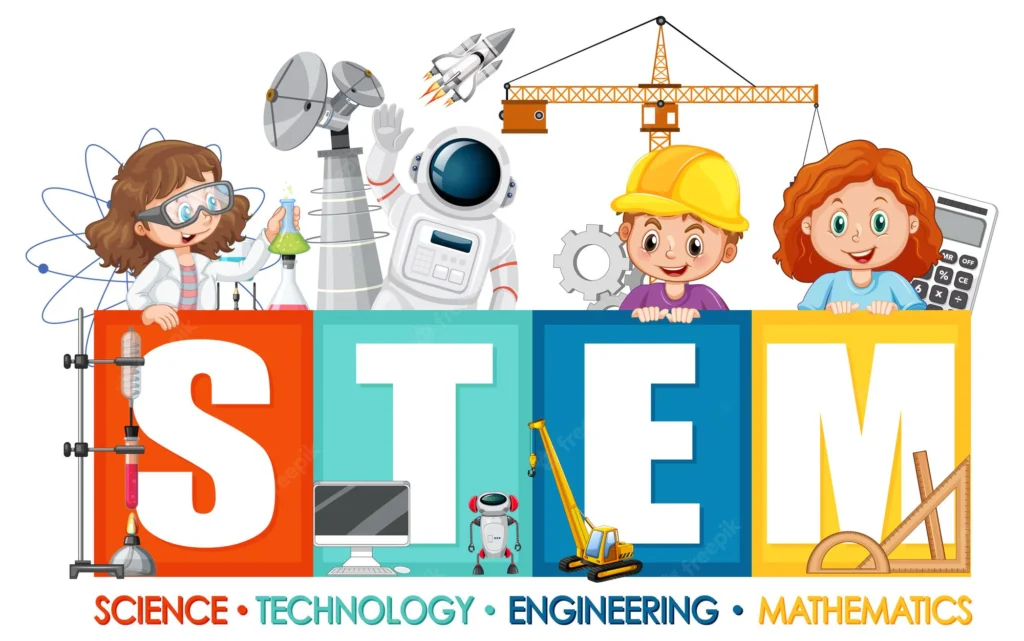STEM is a wholistic approach to education that focuses on developing the students core sciences, critical thinking skills as well as problem solving skills.

Physical sciencedeals with the study of non-living things, like matter, energy, space and time. In general, any of the sciences that deal with inanimate matter or energy, as physics, chemistry, geology, astronomy, etc can be referred to as Physical Science.
Earth sciences basically, are the fields of study that study the solid Earth, its waters, and the air that envelops it. They include the geologic, hydrologic, and atmospheric sciences with the broad aim of understanding Earth’s present features and past evolution and using this knowledge to benefit humankind.
Communication Technology consists of any pieces of technology people use to communicate (interact) with one another. Computer, television, radio, telephone and internet are all products of Communication Technology.
Electrical Technology: Electrical technology involves the design and production of all the electrical systems as well as the installation, testing and maintenance of these systems. Electricity was discovered in the 1700s by Benjamin Franklin.
Energy technology aims to help generate, store and transmit energy for a variety of purposes. Common examples of energy technology include solar panel, wind turbine and batteries.
Manufacturing technology is a term that can refer to a number of modern methods of science, production, and engineering that assist in industrial production and various manufacturing processes.
The four main types of manufacturing are casting and molding, machining, joining, and shearing and forming.
Medical technology is simply the application of science to develop solutions to health problems or issues such as the prevention or delay of onset of diseases or the promotion and monitoring of good health. Medical technologists work in six main areas of the hospital laboratory: chemistry, blood banking, hematology, coagulation, urinalysis and microbiology.
Transportation Technology refers to the technological improvements, tools or techniques, for moving humans, animals, and goods from one place to another, using one or more types of infrastructure and transport. Transportation technology can apply to all modes of transport (air, land, water, pipeline, space, cable), which consist of transport infrastructure, vehicles, and operations. Transportation technology isn’t all just about transporting people. It can also include the technology that helps get our packages and products from point A to point B.
Chemical Engineering: In the broadest sense of the term, chemical engineering deals with chemicals. These engineers design and manufacture materials and products using scientific principles from chemistry, biology, math, and physics. They may also come up with innovative processes to use and transform energy. Chemical engineers can work with microorganisms, food, pharmaceuticals, and fuels. Often performing experiments and other tasks in labs, many also use computers to design experiments.
Mechanical Engineering: Mechanical engineering entails the development and production of mechanical systems and other devices in motion. These professionals use problem-solving, critical thinking, and the principles of math and physics to transform concepts into functional products, such as ships, firearms, household appliances, turbines, and vehicles. Today’s mechanical engineers rely on many of the same core components that have been used for thousands of years, including wheels, springs, screws, and axles.
Electrical Engineering: A newer branch of engineering introduced in the 19th century, electrical engineering focuses on electrical equipment and electronics. These engineers design, test, and maintain devices that use or produce electricity, from small objects like microchips and computers to large-scale projects like satellites and power station generators. Most electrical engineers complete tasks in an office or lab, though on-site work is also common.
Industrial Engineering: The final engineering branch is industrial engineering, which combines engineering with general business practices to reduce costs, improve quality, and increase efficiency. These specialists often find employment in industries related to service, entertainment, and healthcare. As an industrial engineer, you must work well with people. Industrial engineers’ primary tasks may include designing facilities and information systems, managing inventories, overseeing personnel assignments, and ensuring workplace safety.
Other branches of engineering include the following: Aeronautics, Agricultural, Electronics, Mechatronics, Biomedical, Environmental, Petroleum, Polymer and Textile, Petrochemical, Material and Metallurgical, Marine, Robotics, Computer, Aerospace, Biotechnology and Software Engineering.
Arithmetic: It is the oldest and the most elementary among other branches of mathematics. It deals with numbers and the basic operations- addition, subtraction, multiplication, and division, between them.
Algebra: It is a kind of arithmetic where we use unknown quantities along with numbers. These unknown quantities are represented by letters of the English alphabet such as X, Y, A, B, etc. or symbols. The use of letters helps us to generalize the formulas and rules and also helps you find the unknown missing values in the algebraic expressions and equations.
Geometry: It is the most practical branch of mathematics that deals with shapes and sizes of figures and their properties. The basic elements of geometry are points, lines, angles, surfaces and solids.
Trigonometry: Derived from two Greek terms, i.e., trigon (means a triangle) and metron (means measurement), it is the study of relationships between angles and sides of triangles.
Analysis: It is the branch that deals with the study of the rate of change in different quantities. calculus forms the base of analysis.
Number Theory: Number theory, in a general sense, is the study of numbers and their properties. This is the branch of mathematics that helps us to study the relationships between different sorts of numbers.
